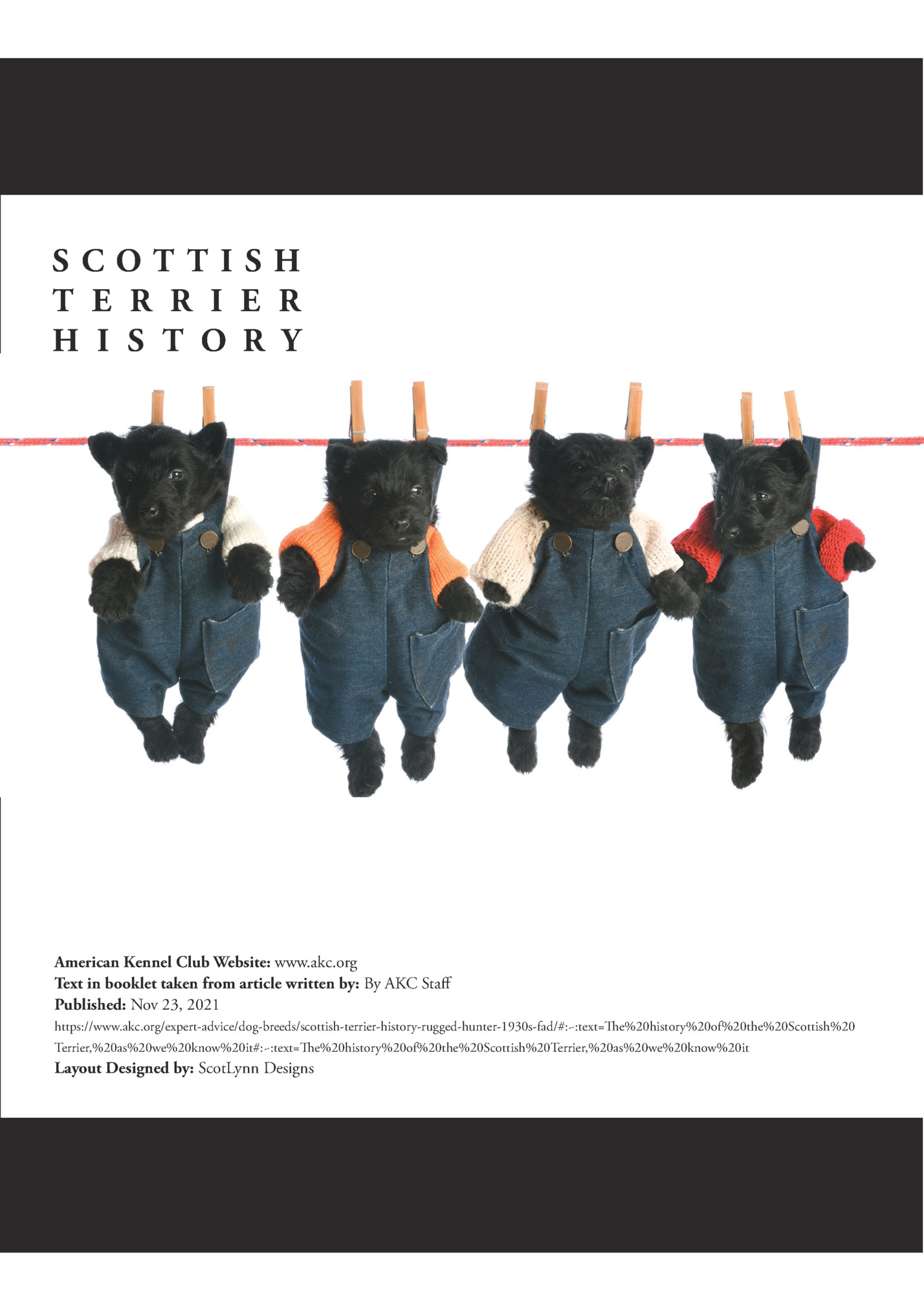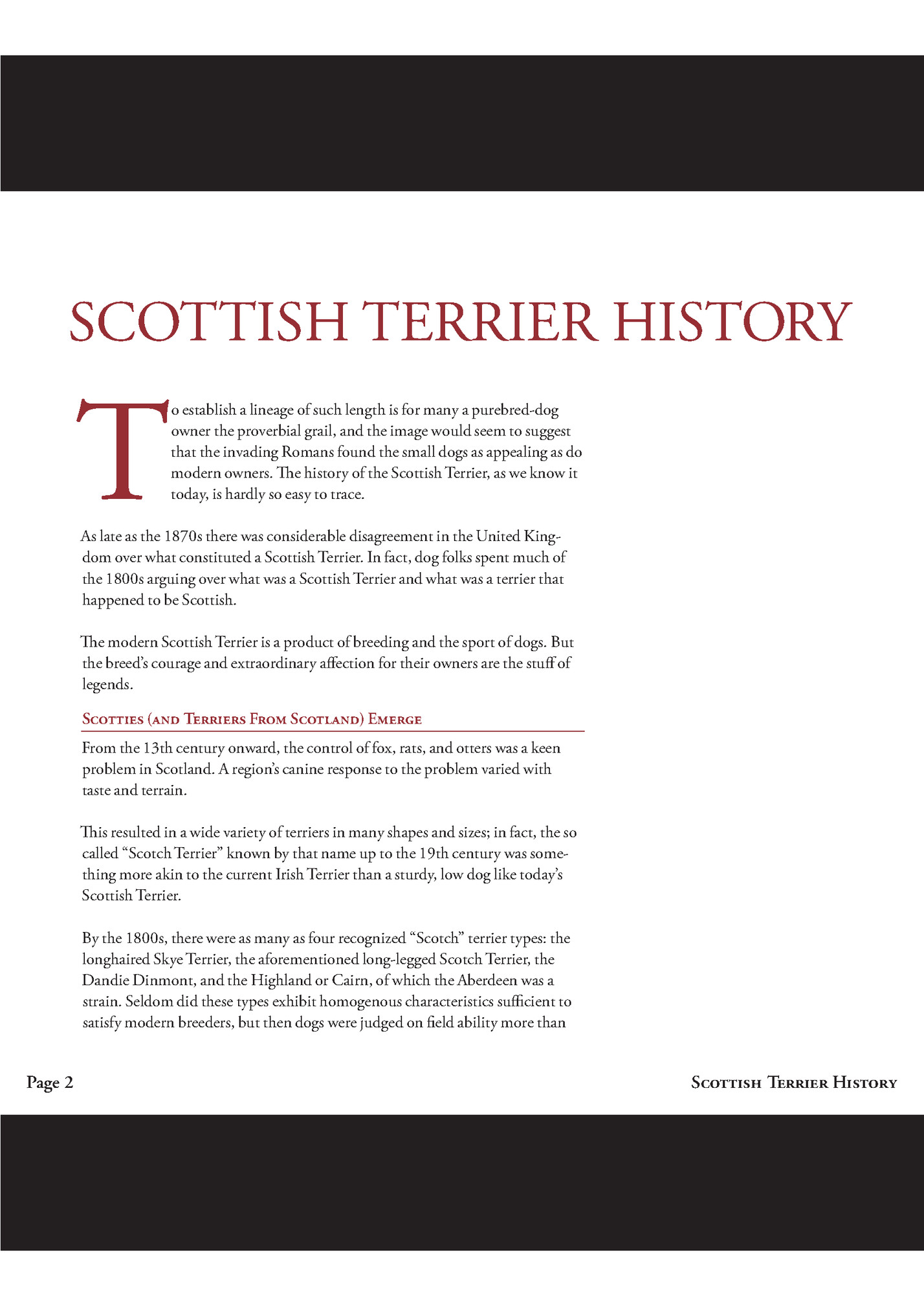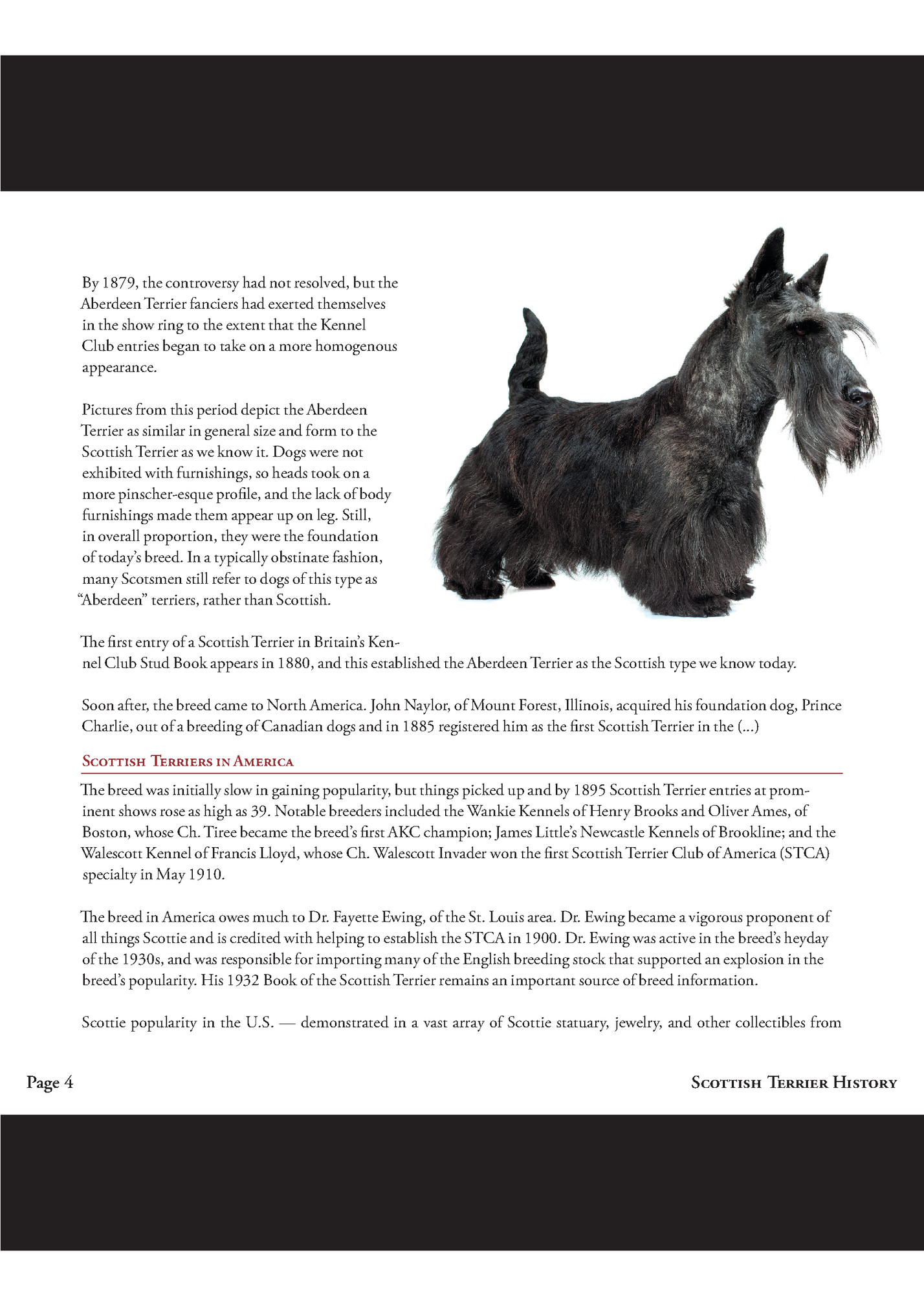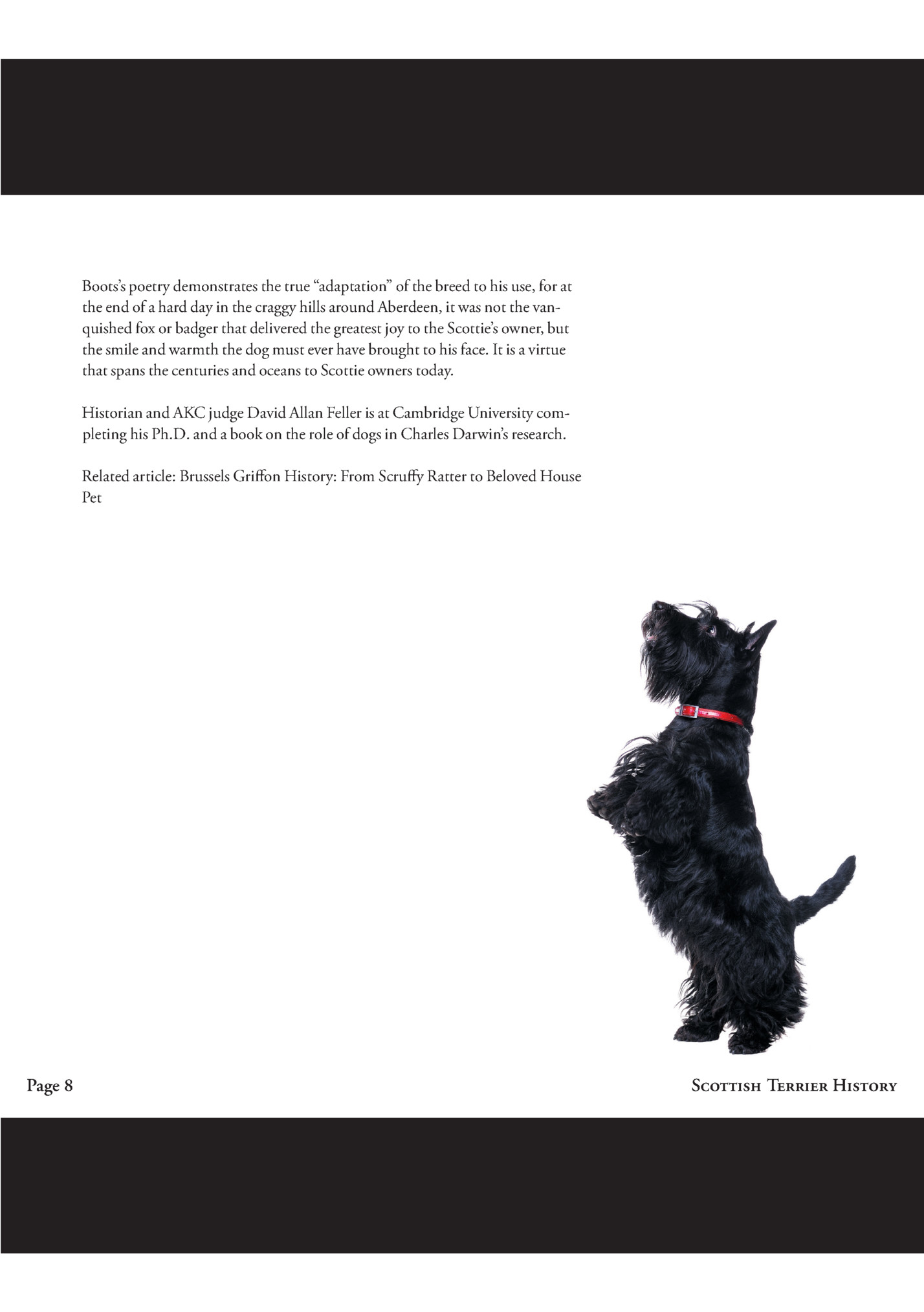T E R R I E R H I S T O R Y American Kennel Club Website: www.akc.org Text in booklet taken from article written by: By AKC Staff Published: Nov 23, 2021 https://www.akc.org/expert-advice/dog-breeds/scottish-terrier-history-rugged-hunter-1930s-fad/#:~:text=The%20history%20of%20the%20Scottish%20 Terrier,%20as%20we%20know%20it#:~:text=The%20history%20of%20the%20Scottish%20Terrier,%20as%20we%20know%20it Layout Designed by: ScotLynn Designs

T o establish a lineage of such length is for many a purebred-dog owner the proverbial grail, and the image would seem to suggest that the invading Romans found the small dogs as appealing as do modern owners. The history of the Scottish Terrier, as we know it today, is hardly so easy to trace. conformation. The first record of a Scotch terrier being shown is at the 1861 Leeds Show. There was, however, no real differentiation between the types at the time; one might see all four types, plus variations of them, in the same ring at a show holding a class for Scotch Terriers (Skyes often had a separate class as well). And that was if there was an entry at all: At the 1875 Crystal Palace show, the single entry was similar to what we would now call a Welsh Terrier, while an entry of two at the 1876 Brighton show included a rough-coated terrier of negligible features, and a Yorkshire Terrier. There was no doubt that all were meant to hunt vermin, and probably originated in Scotland, but beyond that, they shared little in appearance or character. As late as the 1870s there was considerable disagreement in the United Kingdom over what constituted a Scottish Terrier. In fact, dog folks spent much of the 1800s arguing over what was a Scottish Terrier and what was a terrier that happened to be Scottish. The modern Scottish Terrier is a product of breeding and the sport of dogs. But the breed’s courage and extraordinary affection for their owners are the stuff of legends. This confusion over breed type raises questions about some of the more popular stories of Scottish Terrier history, such as the claim that James VI, upon taking the throne of England in 1603, sent for his beloved Scottish Terriers to join him. King James may have called for his terriers, but there still must be questions as to just which terrier that meant. Scotties (and Terriers From Scotland) Emerge From the 13th century onward, the control of fox, rats, and otters was a keen problem in Scotland. A region’s canine response to the problem varied with taste and terrain. Following those early shows, the debate migrated to the pages of the Livestock Journal and Fancier’s Gazette, with people favoring the broken-coated terrier as the “true Skye” terrier, and thus the “true Scotch” terrier, but this notion was equally opposed by patrons of the other Scottish types. This resulted in a wide variety of terriers in many shapes and sizes; in fact, the so called “Scotch Terrier” known by that name up to the 19th century was something more akin to the current Irish Terrier than a sturdy, low dog like today’s Scottish Terrier. Editorial exchanges did not solve the problem. In 1875 in Swindon, another show included classes for “Skye” and “Scotch” terriers, but the entry in each class was not much different from the other! The two dogs exhibited as Skyes best reflected what we now call the Scottish Terrier, and the judges were “bitterly denounced for not recognizing in them the genuine Skye, cast in its original mold and arrayed in its pristine hues.” By the 1800s, there were as many as four recognized “Scotch” terrier types: the longhaired Skye Terrier, the aforementioned long-legged Scotch Terrier, the Dandie Dinmont, and the Highland or Cairn, of which the Aberdeen was a strain. Seldom did these types exhibit homogenous characteristics sufficient to satisfy modern breeders, but then dogs were judged on field ability more than Page 2 Scottish Terrier History Page 3

Aberdeen Terrier fanciers had exerted themselves in the show ring to the extent that the Kennel Club entries began to take on a more homogenous appearance. the period — reached its height in the ’30s, says Stamm. “The 1930s were the golden age of the Scottish Terrier in the United States. I’m sure that the popularity of Franklin Roosevelt and Fala had a lot to do with that,” she says. “I think the highly recognizable outline of the breed was another factor.” Pictures from this period depict the Aberdeen Terrier as similar in general size and form to the Scottish Terrier as we know it. Dogs were not exhibited with furnishings, so heads took on a more pinscher-esque profile, and the lack of body furnishings made them appear up on leg. Still, in overall proportion, they were the foundation of today’s breed. In a typically obstinate fashion, many Scotsmen still refer to dogs of this type as “Aberdeen” terriers, rather than Scottish. Perhaps the breed’s image of gameness took on special appeal as America tried to rebound from the Depression. Along with Roosevelt and the redoubtable Fala, Humphrey Bogart, Bette Davis, authors James Thurber and Dorothy Parker, and pilot Charles Lindbergh were among a long list of famous figures who enjoyed Scottie company. Sturdy Hunters The first entry of a Scottish Terrier in Britain’s Kennel Club Stud Book appears in 1880, and this established the Aberdeen Terrier as the Scottish type we know today. Soon after, the breed came to North America. John Naylor, of Mount Forest, Illinois, acquired his foundation dog, Prince Charlie, out of a breeding of Canadian dogs and in 1885 registered him as the first Scottish Terrier in the (...) Scottish Terriers in America The breed was initially slow in gaining popularity, but things picked up and by 1895 Scottish Terrier entries at prominent shows rose as high as 39. Notable breeders included the Wankie Kennels of Henry Brooks and Oliver Ames, of Boston, whose Ch. Tiree became the breed’s first AKC champion; James Little’s Newcastle Kennels of Brookline; and the Walescott Kennel of Francis Lloyd, whose Ch. Walescott Invader won the first Scottish Terrier Club of America (STCA) specialty in May 1910. The breed in America owes much to Dr. Fayette Ewing, of the St. Louis area. Dr. Ewing became a vigorous proponent of all things Scottie and is credited with helping to establish the STCA in 1900. Dr. Ewing was active in the breed’s heyday of the 1930s, and was responsible for importing many of the English breeding stock that supported an explosion in the breed’s popularity. His 1932 Book of the Scottish Terrier remains an important source of breed information. Scottie popularity in the U.S. — demonstrated in a vast array of Scottie statuary, jewelry, and other collectibles from Page 4 Scottish Terrier History smaller), with a heavy structure and plenty of bone. Because a Scottish Terrier is asked to take after fox and even badger underground, it must be stout enough to rout out such foes; a well-sprung, somewhat heart-shaped rib cage and a short, muscular loin give the dog the tools necessary to hold his ground in close-quarter battle. A long dog, or a dog short on rib, lacks both the agility and power for close-in work in underground lairs. Ample, double thighs complete a sturdy rear end. Though independent Basic Black And More in nature, the Scottie is The coat of the Scottie is Of course, the breed standard foremost defines a hunting given weight equal to the dog. As W. McCandlish wrote in his 1906 volume on body in judging, for it terriers, “the various points (of the Scottie standard) are must protect when fightbut a means towards the true aim of the breeder: A dog ing a fox or other vermin, possessing in perfection the features deemed necessary for and also against the harsh the accomplishment of its work, of symmetrical shape and Highland climate. The grace of carriage, but, above all, full of the characteristics coat is double, with the of its race in form, expression, disposition, and nature. The outer coat broken (i.e., form of the Scottish Terrier implies and fulfills its nature, wire) with a soft underthe expression its disposition.” coat so dense that it does not allow an examiner to The Scottie form is defined by his head, body, and coat, and see the skin if the coat is the standard weights each factor about equally. The Scottie lifted. head is tailored for the work, being somewhat large for the dog’s size and equipped with parallel planes (defining the At one time wheaten was more popular, but it is said that muzzle and top skull) to provide him excellent scenting when hunting with the dogs it was not as easy to tell the ability. His muzzle is ample and should fill a man’s hand. dog from the fox, so the darker dogs came to be preferred. The teeth, given the job the Scottie accepts, must be large and preferably meet in a scissors bite. While the popular impression of a Scottie is that of a black dog, breeder and AKC judge Kathi Brown says it’s importA proper dog weighs from 19 to 22 pounds (bitches slightly ant to emphasize that they come in a rich array of colors, al- pre-eminently revered for his almost-human character. ❦ Page 5

show dogs was silver brindle with a black mask. “She was drop-dead gorgeous,” says Brown, whose line produces predominantly brindle dogs. a wild animal humanized by man.” Owners and breeders alike agree that there is a Scottie temperament, but each dog acquires a unique view of the world and his own character: “Contented in his ways, conscious of the affection he bears to master or mistress, he regards life philosophically, takes the best when he can get it, makes the best when he cannot” wrote one commentator. Even the STCA illustrated standard emphasizes how you can’t judge the book by its cover: “It’s too bad that as judges, you miss seeing the broad and complex character that is the Scottish Terrier. You miss out on the eye rolls, the sighs, the smiles, the selective deafness, and all of the other myriad aspects of Scottie behavior. “I have people who call and say, ‘I want a black dog,’ and I once got so sick of hearing about it, I referred them to my friends who breed Labrador Retrievers,” she says. “I said, do you want a Scottie or a black dog?” Low and Broad From this general description, a Scottie should appear compact, powerfully built, and “willing to go anywhere and do anything.” As the STCA illustrated standard notes, “He should collect himself and appear on full alert, tail, and ears up with excitement. He may stare down his opposition or look away, as if to give the other dogs the opportunity to leave with their dignity and their hides intact.” If a Scottie is shaped to cope with his environment, it is equally so that centuries of life in the rugged Scottish Highlands molded his disposition. Few breeds are so admired for their companionable makeup: Though independent in nature, the Scottie is pre-eminently revered for his almost-human character. Given the Scottie’s generous spirit and empathy for the human condition, it is hardly surprising that Rudyard Kipling’s own Scottish Terrier, Boots, wrote his own book (a trilogy, actually) to describe his attachment to his owner. In The Servant a Dog, Boots, tells of a day of mischief, and realizes that he might possibly have drawn his owner’s disapproval. He spends several sonnets imagining how he might get back into his owner’s good graces: “The breed, for generations, lived among people of imaginative temperament, molded into stern repression by an indomitable fight against Nature in her hardest moods,” wrote McCandlish. And though such a life can be lonely, the “close communion” of such terriers with their owners led to a dog of “extraordinary humanity” and independence, “a domesticated animal with wild instincts, Page 6 Can a gift turn Thee? I will bring mine all My Secret Bone, my Throwing-Stick, my Ball. Or wouldst Thou sport? Then watch me hunt awhile, Chasing, not after conies, but Thy Smile. Scottish Terrier History Page 7

the end of a hard day in the craggy hills around Aberdeen, it was not the vanquished fox or badger that delivered the greatest joy to the Scottie’s owner, but the smile and warmth the dog must ever have brought to his face. It is a virtue that spans the centuries and oceans to Scottie owners today. Historian and AKC judge David Allan Feller is at Cambridge University completing his Ph.D. and a book on the role of dogs in Charles Darwin’s research. Related article: Brussels Griffon History: From Scruffy Ratter to Beloved House Pet Page 8 Scottish Terrier History

Fleepit Digital © 2021